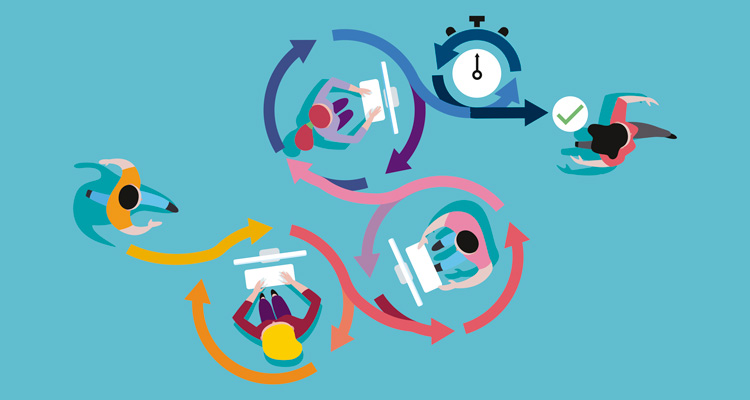
Funding practices – the way businesses allocate budgets internally – are pretty important: They largely determine which projects get prioritized, how teams are structured, and how ROI is measured. If your organization is trying to implement agility at scale, you’ll quickly discover that there are limitations to traditional, project-based budgets and their associated funding practices that must be addressed. It’s not possible to truly achieve organizational agility without evolving these practices.
The key to successfully scaling Agile is to align budgeting and funding practices with the business outcomes the organization is trying to drive. Enter: Lean budgeting.
Lean-Agile budgeting practices help to decrease funding overhead and friction, while maintaining financial governance, and aligning budgeting practices with Lean-Agile goals. In this post, we’ll share the limitations of annual, project-based budgets and how Lean budgeting practices help organizations overcome them.
The Limitations of Annual, Project-Based Budgets
If you consider the key ideas behind Lean and Agile, it’s not hard to see how planning on an annual, project-based basis might not align with your organization’s goals.
Planning on an annual basis hinders agility.
Annual budgeting requires business units to present their ideas to the PMO in a 12-18-month cycle to plan the next year’s work. These ideas are reviewed and prioritized based on perceived value delivery. Then teams are formed for each project and finally, they begin working, usually months (sometimes even years) after ideas first take root.
Budgeting on an annual basis like this makes it incredibly difficult for organizations to truly achieve organizational agility: You can’t adapt to meet the needs of your customers in real time if it takes a year to get projects funded. It’s also hard to make truly timely, data-driven decisions when you have to make them 12-18 months into the future.
There’s also a considerable amount of time and energy involved in developing, communicating, reviewing, and approving ideas on an annual basis – time and energy that could be spent continuously delivering value.
The Lean Budgeting Difference: Continuous Delivery
Lean and Agile are rooted in the idea of continuous delivery: Planning, executing, and delivering work effectively, so that you can gather feedback quickly, and then repeat this cycle. Teams use the data they gather to determine how to prioritize work in the short-term.
Temporary teams rarely achieve high levels of performance
Another limitation of annual, project-based budgeting? Project-based budgeting makes it difficult to achieve higher levels of teamwork and collaboration. This is because it relies on short-lived working relationships: When an idea is prioritized, a temporary team is assembled to make it happen. One person might be part of several such temporary teams, which can each include entirely unique people, making it hard to form close working relationships. When the project is over, the team disbands.
Tuckman’s stages of group development is a framework that might explain how this can have a negative impact on morale. This framework says that groups have to go through each of these stages in order to unlock higher levels of performance and problem solving. The stages are:
- Forming
- Storming (experiencing conflict)
- Norming (learning how to resolve that conflict)
- Performing (working together toward a common goal)
Since project-based teams are temporary, they might only ever form and storm – never experiencing the more gratifying experiences of norming and performing. You probably know from experience what it’s like to struggle to work with someone, until you develop a deeper understanding of who they are, how they work, and the specific skills they offer. After working together, you realize that the things that make you different, actually make you stronger as a team.
Sometimes, teams won’t even get to the storming stage before the project ends – people are less likely to suggest big changes to or critically analyze the work of people (or the project outcomes itself) they don’t know well. This is unfortunate for everybody, because it means the team never actually experiences any of the benefits of collaboration, all of which are reliant on some degree of (healthy) conflict.
The Lean Budgeting Difference: Stable Teams of Teams
A value stream (or Line of Business) is defined as an end-to-end business process and the associated steps an organization takes to deliver customer value, or it may refer to a line of business that delivers value, typically a product or solution, to a customer.
Regardless of how an organization is currently defining a value stream, the purpose of organizing by value stream is generally the same: to deliver products and solutions beyond potentially disjointed project-based delivery. By aligning work and funding to delivery, value is created and managed more effectively.
So rather than trying to fund individual projects, the Lean approach allocates budgets to value streams, with guardrails to define spending policies, guidelines, and practices for that portfolio. This allows for flexibility, autonomy, and speed within each value stream, while maintaining cohesion across the portfolio.
Budgeting decisions are made within each value stream, by the teams within them. Lean-Agile teams are long-lived and self-organizing, meaning that:
- Teams successfully reach the norming and performing stages of group development and unlock higher levels of collaboration
- Teams form stronger working relationships, resulting in higher work quality and better morale
Tackle project-based budgeting challenges with Lean budgeting
As you can see, traditional cost accounting practices are misaligned and counter-intuitive to Lean-Agile delivery. Fortunately, there is a way to maintain financial and appropriate governance while also minimizing the overhead of traditional project-based funding and cost accounting: Lean budgeting.
With Lean budgeting, enterprises can have the best of both worlds: a value delivery process that is far more dynamic and responsive to market needs, as well as clear visibility to and accountability of spending. To learn more, download the full eBook, “7 Stages to Lean Budgeting Success.”
Read part two of this series here.





